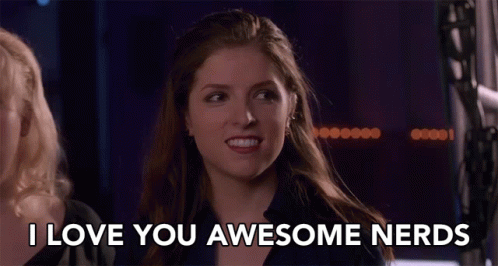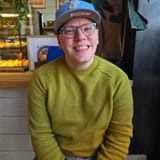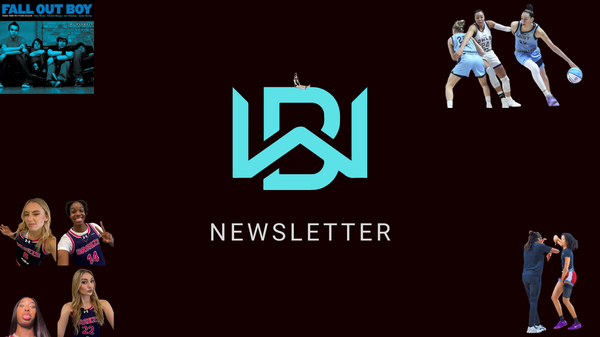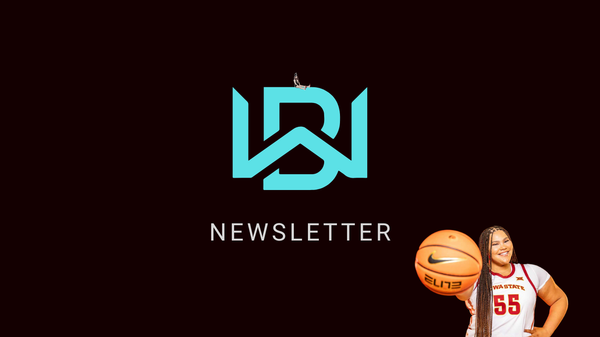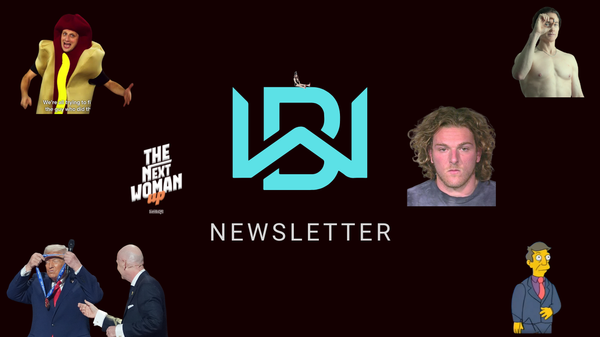A Conversation with Author Blayne Waterloo
I spoke with author Blayne Waterloo leading up to their debut published book dropping later this week. Plus a look at the first two games of the WNBA Finals and the Dodgers pitching strategy.
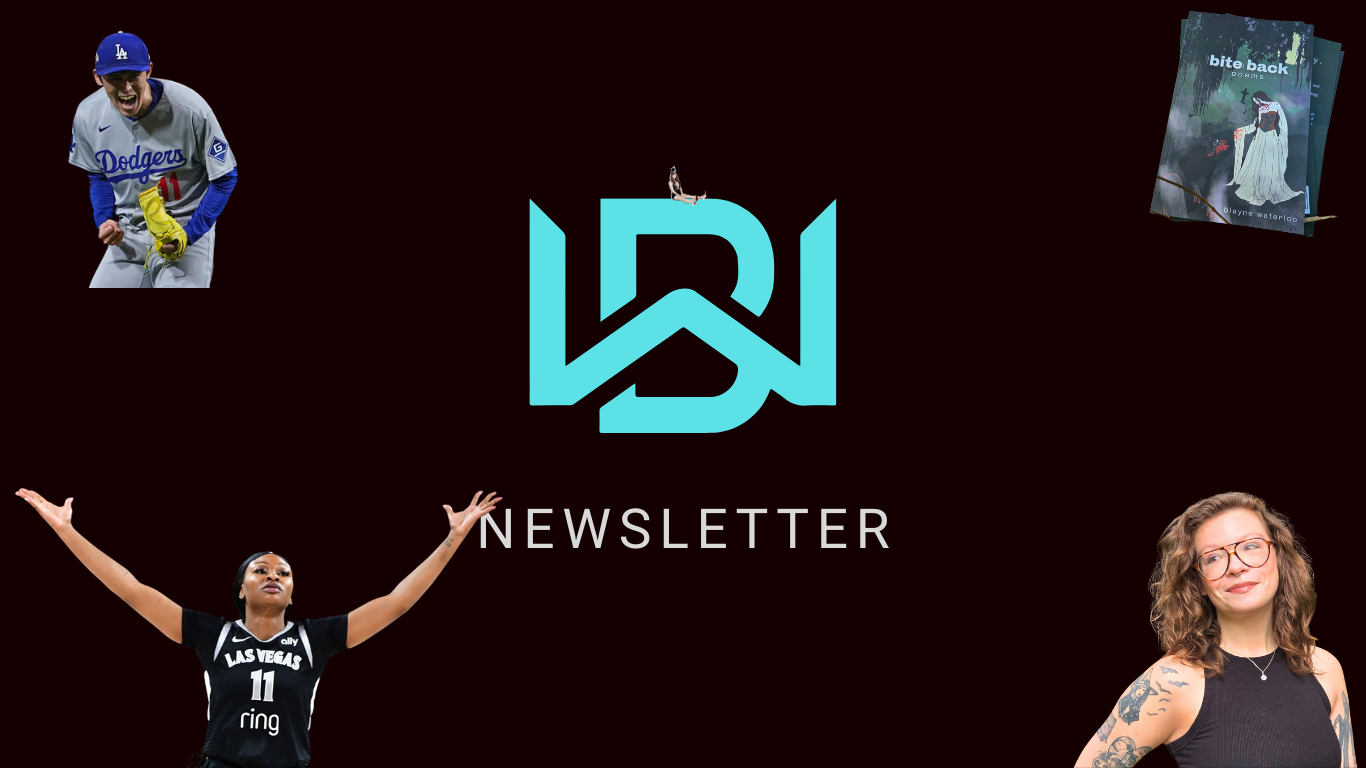
Plus WNBA Finals takeaways, Dodgers' pitching approach, more
I preach often about the importance of being unbiased when it comes to being a journalist. And that's why there's a difference between writers, columnists, reporters, bloggers, and journalists.
I like to have fun with this newsletter, but when I'm reporting on actual stuff, I wear that capital J for journalist proudly.
Today I'm getting into a conflict of interest.
Let's just call it out from the beginning. If this were at a news outlet, I wouldn't be the one writing this.
But it's my newsletter, dammit, so I'm being up front with everyone.
I'm writing about my partner, Blayne Waterloo, who is releasing their first published book this week called "Bite Back."
Blayne, who is my favorite writer, is also a former journalist. While they are used to asking the questions, I turned the tables by being the one to ask the questions this time around.
After our Sunday morning coffee, we sat down on the couch in our living room, and I interviewed Blayne for the first time in our 13-year relationship to learn about the idea behind the book, navigating the publishing experience, being vulnerable, and more.
Michael Waterloo: So your first book, "Bite Back," is coming out this week. What was the idea behind it?
Blayne Waterloo: It was originally supposed to be a much longer collection, and I was kind of just learning as I went what poetry collections looked like. I mean, a lot of us, when we look at poets, it's a lot of poets that have already had a long career or, you know, died a 100 years ago. So we can look at their collections as these big tomes of beautiful, edited, curated history. And so it took me a while to figure out, 'Oh, OK, my first collection should be much smaller to give the world just a taste of who I am and not to give it all away at once.' Because I want my quality work to be out there.
It was supposed to be a book called Undertake Her. And it was supposed to be like four different parts that were basically the undertaking process of a corpse. But that eventually got whittled down to "Bite Back," which was actually the title of a poem that I ended up excluding from this collection. It ended up being like a very much usurped version of all of that and is kind of like a summary of overcoming past trauma and kind of welcoming whatever monster you feel like you've been made to believe you are.
MW: Whenever you're writing your poetry, was the idea always to turn it into a book or did that kind of evolve along the way?
BW: That evolved along the way. Coming back to poetry in my 30s was more of a healing process. It was something that I did in my teens that I knew helped me a lot during tough times. And so when I moved to Georgia with my partner, I kind of wanted to get back to those roots. So I just leaned into poetry as a self discovery thing, not necessarily with any real intention at first.
MW: Is part of the poetry kind of like discovering yourself, that past trauma, but also kind of being in a new place and trying to find your way for this new chapter of your life?
BW: Yeah, I think, I think there is a tone of transition throughout because, yeah, the past two to three years have been all about transitioning to become who I really am and kind of sifting through the parts of me that I built up for others as opposed to what has kind of always been under the surface, that I really just wanted to get back to and focus on.
MW: You said, Undertake Her, it was gonna be initially a four-part book. So are there any thoughts of turning this into like a four-part series to kind of still hold true to that original idea?
BW: You know, I'm not sure because I don't even know which part of that process I would be in if I were to use it as a metaphor still. I think I'm still ... undertaking all of that. It's a better understanding of where I'm at, but so far, I don't know what the next collection is going to look like. I'm kind of just trying to let it happen.
MW: Writing in general is a vulnerable activity, putting it out there so others can read. Poetry is especially vulnerable. How does it feel for you to put something out there that is a piece of you that others are able to see in that way?
BW: It is interesting because I don't necessarily see it as being the most vulnerable I can be. I look to poetry as a way to express myself while still wearing, like some armor, because poetry so often is a metaphor or it's displacing what's actually going on with you and putting it in a different scenario or in a different person on something else entirely. And so, I don't know, I think poetry kind of just allows me to share myself with the understanding that no one person is going to understand it completely and it's going to mean something different to them, and that kind of gives me a sort of cushion of safety.
MW: You have your voice, obviously, in the horror community being an editor for Fangoria, loving horror, the horror tattoos, and everything. Is this kind of to show a different side of you a little bit? Because initially, whenever you think of a Blayne Waterloo book or a podcast or an article, you think horror. But this is a little bit more about yourself, correct?
@ewhag While filming a promo video for their upcoming poetry collection, Blayne Waterloo disappeared. This is that video. BITE BACK: POEMS out October 9! #horrortok #lgbt #fypage
♬ original sound - blayne
BW: I think I very much identify with the term horror. I think anybody who enjoys horror kind of identifies with that gross, dirty, monstrous description that comes along with that genre. So there's a lot of gory, gross, horrific imagery within my poetry and within this book. It kind of would still fall under horror, but to answer the question of it, it's still a little different and not everybody enjoys poetry that way. So yeah, it is a little bit different. And I am a little nervous to put myself out there in that way instead of like, 'oh, sorry, that wasn't very, like, you know, dark hair, black clothes, tattoos of me.'
MW: Well, you can see that side in the previous publication that you put out, just a month ago, a collaborative effort called "Salon Sinister." Can you discuss that a little bit in what readers can expect whenever they kind of dig into that?
BW: 'Salon Sinister' is really just my love letter to the queer horror community and just queers in general. And it was important to me that with 'Salon Sinister,' we focused on voices that might get overlooked at other publications or who might not be considered, I don't know, queer enough or horror enough for others, and allowing for that humanity within queer horror. So 'Salon Sinister' is a literary magazine, but with a zine feel that's a little rougher around the edges and feels a little more vulnerable. And the stories within the poetry within the art within, so much of it when you're reading it or looking at it or just taking it in, it feels like an open wound that nobody has really dressed. And I think that is part of the ... terror that 'Salon Sinister' has to offer because it is very raw, and it is, you know, unfiltered in so many ways. And so to be able to produce this with so many beautiful contributors is so fulfilling. And I think being able to have those voices out there in the world and distribute 'Salon Sinister' the first issue, not only digitally, but physically, keeps those voices alive and cements us within this time in history.
MW: When you talk about the physical part of it, what has it been like navigating that process of publishing not one, but two books, physical copies, for the first time?
BW: It was really daunting. I wasn't sure I wanted to do physical copies at first because I was completely unaware of the process and trying to break into publishing at all is a very confusing and a very gate-kept thing. So I kind of went the self-publishing route and wanted to maintain that quality of, you know, a traditionally published book while doing my own thing, maintaining my own style, and direction. I used IngramSpark and it was so enlightening as to the pricing of everything, how accessible it really isn't, to publish at all, let alone self-publish. And it really takes a lot of patience when designing and laying things out and, gosh, when like sourcing who you're going to go through and whatnot, but it's very rewarding to have been able to figure all of that out and to discover who I can lean on when it comes to questions that I have or navigating something brand new. So I'm very grateful to my partner for encouraging me to do this, to go into publishing these books, but also the editing team on 'Salon Sinister.' I mean, we created something within months that many people only talk about doing ever. And here we are having gotten so much support and been able to sell enough books to really barrel forward into Issue 2 and kind of just keep that momentum. It's beautiful. It's so exciting.
MW: We saw a picture of 'Salon Sinister' at a bookshop in Tennessee. We know the bite back is going to be at one in North Carolina, as well as shops in the UK, California, Barnes & Noble, and other places. What's the feeling going to be like whenever you see it in hand somewhere other than your house?

BW: It's not going to feel real. I deal with delayed processing a lot. I think it's going to be important for me in that moment to kind of just sit there and take it in. But after I take my pictures and let the day kind of wash over me, I'm just going to bawl because being that bookworm kid and having that passion for writing and having to overcome a lot of obstacles that made me think that I wasn't good enough or that my perspective wasn't of value to see it among others that I just adore and respect and look up to ... it's going to be a very healing moment.
MW: You mentioned Undertake Her was initially the name of the book, but now that's the name of your publishing imprint. What's the goal with that? Is it to kind of take it day by day, issue by issue, see what you want to do with that? Or is it in hopes of going with the traditional publishing route while still kind of keeping that part of it?
BW: It really is a date-by-day thing. As I learn more about the industry and how it works – I just joined the Independent Book Publishers Association – and that offers a lot of great resources that I'm still discovering. But yeah, I would love for this to become a place for queer horror. A place that's just a little off or a little weird and helps the misfits feel seen.
WNBA Finals Takeaways Through Game 2
The Aces are sitting at 2-0 in the WNBA Finals after a nail-biting Game 1 victory after Alyssa Thomas missed key free throws and a dominant Game 2 showing.
As the series moves to Phoenix on Wednesday, here are the five biggest takeaways that I have through the first two games.
- Aces Guard Play
In Game 1, it was Dana Evans and Jewell Loyd who showed up big time off the bench for the Aces. They were the two best players on the court for the Aces in the first game, and if you saw Becky Hammon's comments, it makes sense why.
After game one, Becky Hammon commented that Jewell Loyd and Dana Evans having such a big game made it easier on Jackie and A'ja because they were a little tired from the semifinals. She said yesterday that they would be ready to go for today. Uhhh, she was right.
— Maggie Hendricks (@maggiehendricks.bsky.social) 2025-10-05T20:32:09.857Z
In Game 2, it was Jackie Young and Chelsea Gray who were running the show for the Vegas' backcourt. Young had 21 points in the third quarter – and WNBA Finals high for a single quarter – and Chelsea Gray was making jaw-dropping passes left and right.
Chelsea Gray has been magnificent in game 2. Look at the defense move with her on the 2nd angle. A basketball savant. #WNBASky
— Daniel Thompson (@dr-thompson.bsky.social) 2025-10-05T20:24:32.861Z
She's still in a league of her own when it comes to court vision.
The guard play has been huge for the Aces not just offensively, but defensively, as well. They've done a great job causing havoc inside the paint, creating disruption and deflections leading to turnovers.
The Aces have gone to a lineup with four guards – the four mentioned above – and A'ja Wilson, and haven't lost anything defensively. Evans held her own against Dewanna Bonner in Game 1, and Young and Loyd held their own against Alyssa Thomas.
The guards truly dictate how the Aces play.
- Satou Sabally ... what are you doing?
The two reactions that I let out the most during the first two games were "oh shit!" for a Chelsea Gray pass and then a "what are you doing, Satou?"
She's been insanely frustrating to watch this series. Nineteen points in Game 1 and 22 points in Game 2. Yeah, I get it. They look fine.
But it's been anything but.
What makes Sabally a unicorn is that she is able to be an elite three-level scorer, but she forces way too many three-point attempts.
Watch Game 2 back.
Notice that she starts hitting her shots in the fourth when she's set and the offense creates good looks for her.
Where she struggles is when she forces a three within the first 10 seconds of the shot clock before the Mercury can get into their motions.
It's been a struggle offensively and defensively for Sabally, and when she gets going, it's been too little too late.
- Coaching Adjustments
I'm not a Dakota expert. I don't know if North Dakota or South Dakota is considered superior. I know that both Nate Tibbetts and Becky Hammon have the South Dakota ties. But whichever Dakota is considered superior, that's Hammon.
Tibbetts is the other.
The Mercury's coach has been so stubborn during Finals. A'ja Wilson catches the ball on the block. A'ja Wilson drives the lane. A'ja Wilson dives off a screen. A'ja Wilson gets the ball at the three-point line.
She can do what she wants, because the Mercury – thanks to Tibbetts – refuse to adjust to mix up defensive looks or at least double the four-time M'VP.
Then, in a game that once again had a lot of ticky-tack fouls – including two on Alyssa Thomas while guarding Wilson, forcing the Mercury to move Thomas off of Wilson – Tibbetts just held his challenge.
Just sat there and held it like a newborn puppy (OK, I get it and that's cute).
But he finally used his challenge.
With less than two minutes to go.
With the Aces up 12.
And the backups on the court.
He lost the challenge.
Hammon has out-coached Tibbetts in every single way.
- A'ja Wilson does what she wants
I don't mean this in the way that Aliyah Boston means where Wilson has a special whistle. I mean it in the way that you can't do anything to stop her. I've heard stories – and witnessed it multiple times – where coaches were (seriously) asked what you can do to stop A'ja Wilson?
You can't. That's the answer, and they gave it (mainly) in a nice way.
You can make it more difficult on her (like we mentioned above) by not allowing her to dissect the defense, get deep position, and get easy looks. But she's still going to get hers. You need to force players like Young, Loyd, and Gray to beat you.
They did that in Game 2, but that's still the recipe.
- A Full Game for Kahleah Copper
I'm nitpicking here because Copper has come out on fire to start both of the Finals' games so far. But while she scored 19 points in the first half of Game 1 and Game 2, she ended up scoring two points in the second half in Game 1 and four points in the second half of Game 2.
The Mercury's three-point shooting (5-of-28) was abysmal in Game 2, but when Copper is locked in like she has been in the first halves of the first two games, they can overcome that.
Expect to see a full-game Playoff Copper performance in Game 3 on Wednesday.
The Dodgers (derogatory) are Managing Their Bullpen Like I do (laudatory)
I have no doubt that the Dodgers are going to not just make the World Series, but win it again.
While I'm writing this, the Dodgers are up 1-0 on the Phillies in the NLDS after a big go-ahead home run by Teoscar Hernández off of Matt Strahm in the seventh inning.
Starting to believe Teoscar Hernandez intentionally screws up in the field just to hit dramatic home runs, 3 run shot gives the Dodgers a 5-3 lead
— CJ Fogler (@cjzero.bsky.social) 2025-10-05T00:52:15.576Z
The question for the Dodgers, though, is how they'll overcome their pretty bad bullpen.
They went to the Michael Waterloo school of learning, it seems.
Well, the Michael Waterloo MLB The Show franchise mode school of learning, at least.
I mainly play EA Sports College Football and Call of Duty: Warzone, but I still have fun with NBA2k and MLB The Show.
I don't mess with the online play or the virtual cards or any shit like that.
I'm a millennial, dammit, so I play franchise mode – offline, at that.
And with both 2k and The Show, I use a fantasy draft to build my own team.
When I'm doing it in MLB The Show, I have one rule that I always use: never draft relievers.
What I do instead is fill out my bullpen with pitchers with two-plus pitches who are backend starters or elite pitching prospects and rotate them in.
Most bullpen arms are failed pitching prospects anyway, so why not just get the jump on it?
The Dodgers' answer to their bullpen woes in Game 1 against the Phillies was to turn to Tyler Glasnow in a multi-inning role since they have plenty of rest before he starts Game 4 for them. He made his first relief appearance since 2018, working 1.2 innings before turning it over to Alex Vesia to get the final out of the eight inning.
Then, to shut the door, the Dodgers turned to rookie starter – who struggled and subsequently missed four months with a shoulder injury – Roki Sasaki to close out the ninth inning with pure filth.
Is this a realistic approach for the regular season? No, of course not. It's why real baseball is, well, real, and I play video games.
But it's the perfect answer for the postseason when bullpen performance is so important and a team like the Dodgers is lacking true standout performers to close games.
Until Next Time
We'll be back on Friday unless something crazy happens for the third week in a row where we publish earlier.
Either way, I love you awesome nerds.
See you then.
